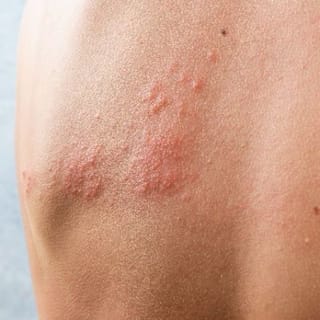 Shingles is a rash caused by the reactivation of the chickenpox virus (also known as the varicella zoster virus or VZV). Classically, the rash affects only one side of the body, within a single stripe or band known as a dermatome. There may be a prodrome consisting of pain, itching, or tingling localized to the area before the rash appears. This is followed by the development of a painful rash and blisters. Over the course of 7-10 days, the blisters rupture, scab, and crust over. Though the rash may completely resolve in 2-3 weeks, some individuals continue to experience nerve pain in the affected area that can last for months to years (known as postherpetic neuralgia). Older individuals and those with a weakened immune system may be more vulnerable to getting shingles. Although there is no cure, vaccines and oral antiviral medications are available to prevent the disease and lessen the discomfort and symptoms.
Shingles is a rash caused by the reactivation of the chickenpox virus (also known as the varicella zoster virus or VZV). Classically, the rash affects only one side of the body, within a single stripe or band known as a dermatome. There may be a prodrome consisting of pain, itching, or tingling localized to the area before the rash appears. This is followed by the development of a painful rash and blisters. Over the course of 7-10 days, the blisters rupture, scab, and crust over. Though the rash may completely resolve in 2-3 weeks, some individuals continue to experience nerve pain in the affected area that can last for months to years (known as postherpetic neuralgia). Older individuals and those with a weakened immune system may be more vulnerable to getting shingles. Although there is no cure, vaccines and oral antiviral medications are available to prevent the disease and lessen the discomfort and symptoms.
Disclaimer:
The information on this website is provided for educational and information purposes only and is not medical advice. Always consult with a licensed medical provider and follow their recommendations regardless of what you read on this website. If you think you are having a medical emergency, dial 911 or go to the nearest emergency room. Links to other third-party websites are provided for your convenience only. If you decide to access any of the third-party websites, you do so entirely at your own risk and subject to the terms of use for those websites. Neither David Fivenson, MD, Dermatology, PLLC, nor any contributor to this website, makes any representation, express or implied, regarding the information provided on this website or any information you may access on a third-party website using a link. Use of this website does not establish a doctor-patient relationship. If you would like to request an appointment with a health care provider, please call our office at (734) 222-9630.








